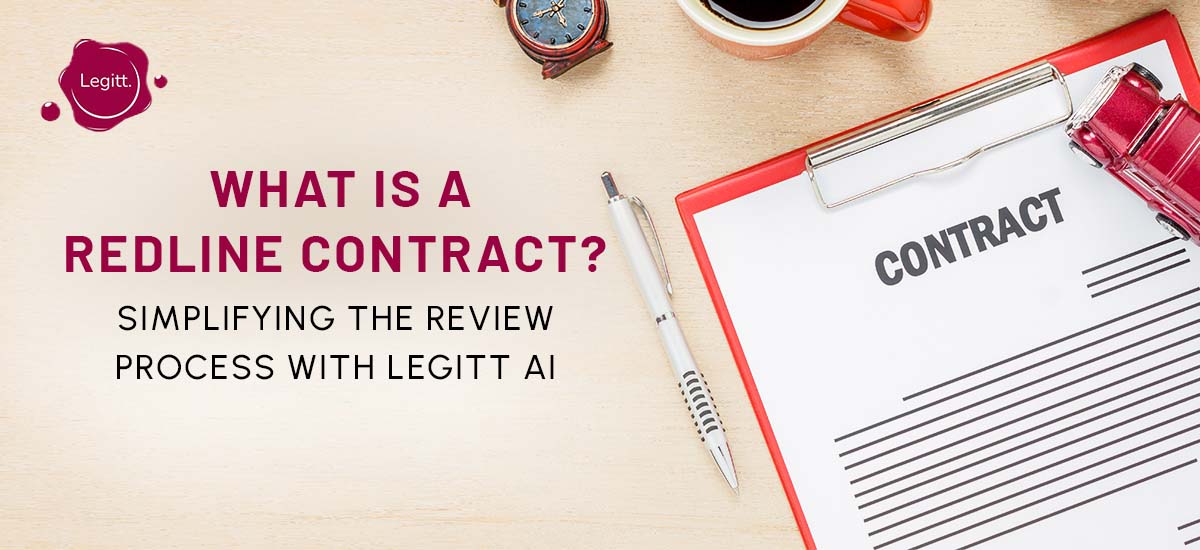Contracts play a vital role in establishing legal agreements between parties, but ensuring their terms accurately reflect the intended understanding can be challenging. This is where redline contracts come into play. Redlining is the process of editing a contract when two or more parties are negotiating or working together. The goal is to produce a single document that satisfies all parties. In this article, we will explore what contract redlining entails, how to perform it effectively, when it should be employed, the challenges associated with redlining contracts, and how Legitt AI simplifies and streamlines the redlining process.
What’s Inside
What is Redlining a Contract Mean?
Contract redlining involves carefully reviewing its provisions and making changes to the text to reflect the intended modifications. The purpose is to produce a single document that satisfies all parties. The term “redline” originates from the practice of marking proposed modifications and additions in red ink to differentiate them from the original contract language. This visual distinction makes it easier for parties to identify and understand the proposed changes during the negotiation process.
Also Read: Contract administration vs contract management
How to Redline a Contract?
Traditionally, contract redlining was done manually with physical copies of the contract. However, with the advent of digital technology, the process has become more efficient and accessible. To redline a contract, one can use track changes or similar tools in word processing software. These tools allow for easy identification and highlighting of modifications, making it clear which sections of the contract are being altered. One such tool is Legitt contract management software solutions which are highly user-friendly for every business.
When redlining a contract, it is crucial to provide clear and concise comments explaining the rationale behind the proposed changes. This ensures that all parties involved have a complete understanding of the intended modifications and can engage in meaningful discussions during the negotiation process.
Also Read: What can contract management software ensure
When Should You Redline a Contract?
Redlining a contract is recommended in several scenarios:
1. Ambiguity or Lack of Clarity: If there are types of clauses in a contract that are unclear or open to interpretation, redlining can help clarify the language and ensure all parties are on the same page.
2. Conflicting Expectations: When the expectations of the parties involved do not align with the language in the contract, redlining can be used to bridge the gap and create a mutually satisfactory agreement.
3. Material Changes: If significant changes need to be made to the key elements of contract management due to evolving circumstances or new considerations, redlining enables parties to negotiate and incorporate these changes effectively.
4. Legal Compliance: Redlining may also be necessary to ensure contract compliance management with applicable laws and regulations.
Read More: What is CLM
Challenges of Contract Redlining
While redlining is a crucial step in contract negotiation, it is not without its challenges. Some common difficulties include:
1. Time-Consuming Process: Contract reviewing and making changes to a contract can be a time-intensive task, especially when dealing with lengthy and complex agreements. Parties must invest significant effort and attention to detail throughout the redlining process.
2. Version Control: Managing multiple versions of a contract during the redlining process can be confusing. Ensuring all parties have the correct and most up-to-date version can lead to potential errors and miscommunication.
3. Collaboration and Communication: Effective collaboration and communication among parties are essential during contract redlining. Coordinating discussions, tracking changes, and managing feedback can become challenging, particularly when multiple stakeholders are involved.
4. Human Error: Redlining manually can leave room for human error, such as overlooking critical changes, misinterpreting comments, or making unintended modifications.
Also Read: How to write a contract proposal
Effectively Managing Contract Redlining
To overcome the challenges associated with contract redlining, organizations can implement contract redlining best practices, such as:
Establishing open and transparent communication channels among all parties involved is crucial. Regular meetings and discussions can help clarify expectations, address concerns, and ensure everyone is on the same page throughout the redlining process. Leveraging technology can greatly enhance the efficiency and accuracy of contract redlining. Contract management platforms, like Legitt AI, offer features such as collaborative editing, version control, and automated tracking of changes. These tools streamline the process, improve organization, and reduce the risk of errors.
Developing standardized guidelines and templates for redlining can promote consistency and streamline the review process. Clear instructions on how to mark changes, provide comments, and resolve conflicts can save time and minimize confusion. Involving legal professionals with expertise in contract review can ensure that all legal implications and obligations are properly addressed. They can offer insights, identify potential risks, and provide guidance on specific contract terms.
Establishing a well-defined workflow that outlines responsibilities, deadlines, and escalation procedures helps keep the redlining process on track. Clearly assigning roles and responsibilities to individuals involved ensures accountability and progress. Proper redlining legal document management is crucial during contract redlining. Storing contracts in a centralized repository, organizing them systematically, and maintaining a comprehensive audit trail of changes and communications helps mitigate risks and facilitates easy access to previous versions.
Read More: Contract lifecycle management blockchain
How Legitt AI Makes Contract Redlining Easier?
Legitt AI is an advanced contract management platform that significantly simplifies the redlining process. Here are some key ways in which Legitt AI streamlines contract redlining:
1. Collaborative Editing: Legitt AI allows multiple parties to collaboratively edit contracts in real-time, eliminating the need for back-and-forth email exchanges and ensuring all stakeholders have access to the most recent version.
2. Track Changes and Comments: Legitt AI provides track changes functionality, making it easy to identify modifications made during the redlining process. Additionally, users can add comments to specific sections of the contract, facilitating clear communication and enabling efficient resolution of issues.
3. Version Control: The platform automatically tracks and maintains a comprehensive version history, ensuring that all parties have access to the correct and most up-to-date contract version. This eliminates the confusion associated with managing multiple redlining legal document versions.
4. AI-powered Assistance: Legitt AI utilizes artificial intelligence to assist with contract review. It can automatically identify potential issues, suggest improvements, and flag legal risks, saving time and enhancing accuracy.
5. Workflow Automation: Legitt AI offers customizable workflows, allowing organizations to define their redlining processes. This contract automation helps streamline the review process, ensures consistency, and reduces administrative burdens.
6. Integration and Reporting: Legitt AI integrates with other systems, such as CRM or document management tools, enabling seamless data flow and enhancing overall contract management. The platform also generates reports and analytics, providing valuable insights into the redlining process and contract performance.
Also Read: Implied contract definition
Conclusion
Redlining a contract is an essential step in the negotiation process, ensuring clarity, alignment, and legal compliance. However, it comes with its own set of challenges. Leveraging technology, such as Legitt AI, can greatly simplify and streamline the redlining process, overcoming common obstacles and improving overall efficiency. By enabling collaborative editing, offering track changes and commenting features, ensuring version control, providing AI-powered assistance, automating workflows, and integrating with other systems, Legitt AI empowers organizations to effectively manage contract redlining and enhance their contract management practices.
Did you find this Legitt article worthwhile? More engaging blogs about smart contracts on the blockchain, contract management software and electronic signatures can be found in the Legitt Blogs section. You may also contact Legitt to hire the best contract lifecycle management services and solutions.
FAQs About Contract Redlining
What does it mean to redline a contract?
To redline a contract means to review and make changes to its provisions. The term "redline" refers to marking proposed modifications and additions in red ink to differentiate them from the original text.
What does a redline contract look like?
A redline contract typically consists of the original contract text with proposed modifications highlighted in red ink. The changes may be indicated through strikeouts or deletions for removed language and underlined or added text for new or modified provisions.
What does it mean to redline a contract?
To redline a contract means to review and mark it with changes or proposed modifications. This process involves highlighting or indicating revisions, deletions, additions, or comments in a visible manner, typically using coloured ink or track changes in digital documents.
What is the best way to redline a contract?
The best way to redline a contract is by utilizing technology such as track changes in word processing software or specialized contract management platforms. These tools allow for efficient highlighting of modifications, clear commenting, and easy collaboration among multiple parties involved in the review process.
What are the benefits of contract redlining?
Contract redlining offers several benefits, including improved clarity and understanding of contract terms, alignment of expectations between parties, identification and resolution of potential issues, enhanced legal compliance, and a more accurate and tailored agreement that reflects the negotiated terms and conditions.
What is the red hand rule in contracts?
The "red hand rule" is a legal principle that states when a party signs a contract with a provision that they did not read or understand, they cannot later claim ignorance or be excused from the obligations stated in that provision.
Is redlining safe?
Redlining itself is a safe practice when performed within the bounds of legal and ethical guidelines. It involves reviewing and proposing changes to contracts. However, it is important to exercise caution, accuracy, and adhere to relevant laws and regulations during the redlining process.
What is the goal of redlining?
The goal of redlining is to ensure that a contract accurately reflects the intended agreement and addresses the concerns and objectives of all parties involved. It aims to clarify terms, resolve ambiguities, and align the contract with the desired expectations and requirements.























